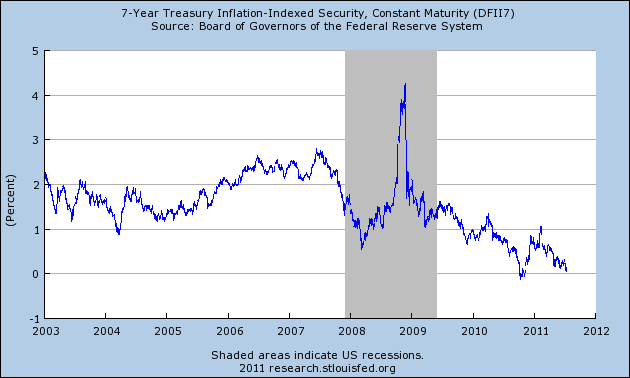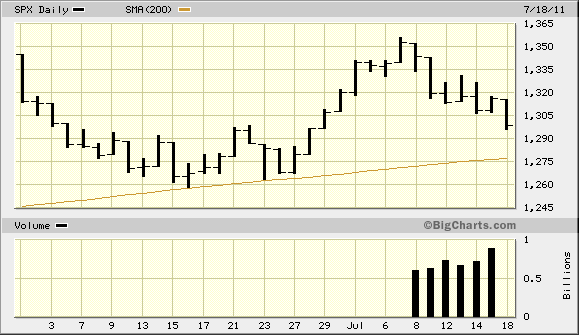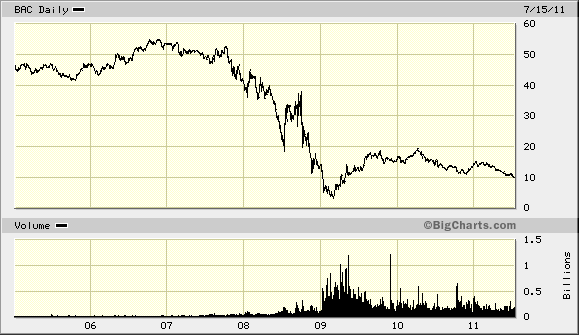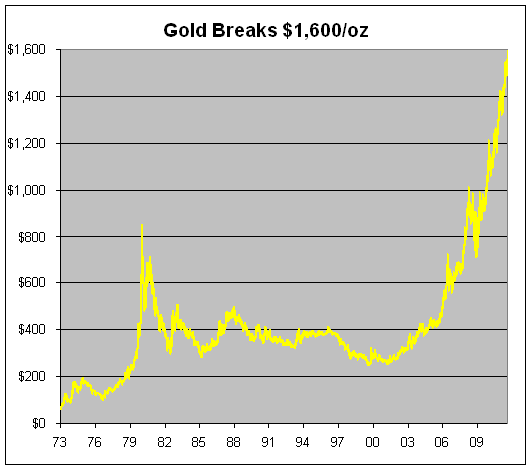Archive for 2011
-
Morning News: July 19, 2011
Eddy Elfenbein, July 19th, 2011 at 7:05 amEU Struggles to Convince on Greek Deal
China’s Treasury Holdings Make U.S. Woes Its Own
Europe’s Economic Powerhouse Drifts East
Gold May Snap Best Run in 31 Years as Advance to Record Price Spurs Sales
Obama Vows Fight Over Efforts to Weaken Dodd-Frank
Wall Street’s Newest Regulator a Longtime Foe
Wynn Second-Quarter Profit Jumps on Return of Gamblers to Macau, Las Vegas
I.B.M. Reports Strong Second-Quarter Earnings
Borders Forced to Liquidate, Close All Stores
Murdoch Struggles to Control News Corp. as Phone-Hacking Scandal Escalates
Cisco Cuts 6,500 Workers, Record $1.3B in Costs
Clorox Rejects Icahn’s $10.2 Billion Offer, Adopts Shareholder Rights Plan
Joshua Brown: Caption Contest Monday: Debt Ceiling 101
Howard Lindzon: The Cotton Crash…The Q-tip Bear Market of 2011
Be sure to follow me on Twitter.
-
Seven-Year TIPs Now Negative
Eddy Elfenbein, July 18th, 2011 at 3:05 pmThe yield on the seven-year inflation-protected bond dropped into negative territory today. This is very close to an all-time low yield.
In February, the yield was just over 1%. Last October, the seven-year hit a low yield of -0.12%.
-
A Third Bounce For the 200-DMA?
Eddy Elfenbein, July 18th, 2011 at 1:10 pmThe S&P 500 has dipped below 1,300 today. It’s very possible that we’re headed for a third test at the 200-day moving average. The current 200-day moving average is close to 1,278.
-
Bank Of America’s Black Hole
Eddy Elfenbein, July 18th, 2011 at 9:11 amBank of America ($BAC) is even in worse shape than I thought:
Bank of America Corp. (BAC) may have to build its capital cushion by $50 billion and renege again on Chief Executive Officer Brian T. Moynihan’s pledge to raise the firm’s dividend as mortgage losses drain funds.
Expenses tied to soured home loans may total $20.4 billion in the second quarter, pulling the bank further from capital ratios demanded under new international standards, the Charlotte, North Carolina-based company said June 29. The gap may equal 2.75 percent of risk-weighted assets starting in 2013 — at about $18 billion for each percentage point — crimping Moynihan’s ability to raise dividends and repurchase shares.
“They are likely to be in capital-building mode for longer than previously anticipated,” Jason Goldberg, a Barclays Capital analyst, said in an interview. For now, he said, “I’m hard-pressed to see meaningful capital redeployment.”
Moynihan, 51, has booked about $30 billion in settlements and writedowns to clean up mortgage liabilities at the biggest U.S. bank since succeeding Kenneth D. Lewis last year. As the costs mounted, Bank of America’s stock declined 25 percent this year, the worst showing in the 24-company KBW Bank Index. The company reports second-quarter results tomorrow and has told investors to brace for a loss of as much as $9.1 billion.
The stock is currently worth about twice what the bank earned in 2006.
-
Gold Breaks $1,600/Ounce
Eddy Elfenbein, July 18th, 2011 at 8:57 amGold is up for the 11th day in a row, and very likely, we’re heading for our 11th-straight yearly gain. Gold just broke $1,600 per ounce in London. Silver is up even more this year.
I think the latest rally in gold is due to the realization that the Federal Reserve won’t be raising interest rates any time soon. In fact, with the election coming up in 15 months, we may not see an interest rate increase until 2013, at the earliest.
Immediate-delivery gold gained as much as $9.85, or 0.6 percent, to $1,603.40 an ounce and traded at $1,602.05 by 1:04 p.m. in London. Prices are up for an 11th day, the longest streak of gains since July 1980. Gold for August delivery was 0.8 percent higher at $1,603 an ounce on the Comex in New York after reaching a record $1,603.80.
-
Morning News: July 18, 2011
Eddy Elfenbein, July 18th, 2011 at 7:27 amAllianz’s Achleitner Suggests Voluntary Swap for Greek Bonds
Allegations Against Chinese Companies to Continue, Affect Funding – Fitch
Stocks, Euro Drop on EU Crisis Concerns
Pain Builds in Europe’s Sovereign Debt Risk
Investors Boost Bullish Commodity Bets
Moody’s Suggests U.S. Eliminate Debt Ceiling
Hertz Will Pay $250 Million to Buy Leasing Firm Donlen
Philips Chief Makes $2.8 Billion Bet on Overhaul to Meet Goals
Google CEO Page Adds About $1.9 Billion in Personal Wealth After Earnings
Man to Acquire Lehman Estates Liabilities From GLG Funds
No Bidders for Borders as Deadline Passes
Fast Traders, in Spotlight, Battle Rules
Phil Pearlman: Google Behaving Like Its Too Small Too Fail
Epicurean Dealmaker: The Cheapest Substance in the World
Be sure to follow me on Twitter.
-
Google Soars on Earnings
Eddy Elfenbein, July 15th, 2011 at 11:40 amLast month, I highlighted how inexpensive shares of Google ($GOOG) had become (which was actually a follow-up from a similar post in May).
I noted that the premium for Google’s valuation was just 8.8% based on this year’s earnings, and 6.5% based on next year’s. Yesterday, the company reported Q2 earnings of $8.74 per share which was 89 cents higher than estimates. The stock has been up as much as $71 today.
-
CWS Market Review – July 15, 2011
Eddy Elfenbein, July 15th, 2011 at 8:10 amThe second-quarter earnings season has officially begun. Very soon we’ll get a handle on how well Corporate America fared during the second three months of the year. So far, we’ve had good earnings reports from companies like Google ($GOOG) and Yum Brands ($YUM). If all goes well, this earnings season will mark a new all-time record for corporate profits.
The current earnings record was set during the second quarter of 2007 when the S&P 500 earned $24.06. Not long after, things fell apart in a serious way. The good news is that we’ve recovered strongly. Wall Street’s current consensus for this year’s Q2 is $24.13 which would be a new record although not by much (and less than inflation over the last four years). Still, it’s nearly a 75% increase over the Q2 earnings of 2009. More importantly for us, the S&P 500 is over 15% lower than it was four years ago today despite earnings being higher.
Let me explain what’s happening. The earnings outlook is still very favorable for most companies. The S&P 500 has a shot of earning $100 this year and perhaps as much as $112 next year. However, earnings growth is decelerating, meaning that earnings are growing but at a slower rate. Second-quarter earnings will probably come in around 15% higher than last year’s Q2.
This slowing rate of growth is concerning many money managers and that’s part of the reason why the market has been jittery lately. Consider that every day this week, the S&P 500 has closed more than 1% below its high for the day. Simply put, the very easy money has been made. Now folks are madly searching for bargains and anything less than perfection gets tossed aside.
I’ll give you an example of what I mean: DuPont ($DD) will probably earn close to $4 per share this year. At the low from 2009, the stock was going for just over $16 per share. In other words, DuPont’s stock was going for just four times earnings from just two years into the future! And we’re not talking about some unknown pink sheet listing. This is a Dow component and one of the largest industrial companies in the world. It was a stock screaming to be bought (and yes, I missed it).
Now let’s look at what’s been happening to DuPont. Three months ago, the company reported very solid earnings for Q1 (15 cents higher than the Street) and raised expectations. So what did the stock do? It went down. Two months after the earnings report, DuPont was trading 10% lower than before its earnings report.
Don’t get me wrong. I don’t mean to pick on DuPont; it’s a fine company. But I want to show you just how nervous investors have become, especially about cyclical stocks. Since mid-February, the Morgan Stanley Cyclical Index (^CYC) has trailed the S&P 500 by roughly 3.5%. When a stock that’s delivering on earnings is getting smacked around, you know something’s up. The lesson here is that investors have been scared and they’ve been looking for reasons to sell. When the problems in Europe came along, that seemed like as good a time as any.
What investors need to understand is that the earnings are still out there, but they’re not nearly as easy to find as they used to be. Another example is JPMorgan Chase ($JPM), a Buy List stock, which reported very good earnings on Thursday. For last year’s Q4 and this year’s Q1, I was highly confident that JPM was going to beat the Street’s estimate, and I was right both times. This time around, I wasn’t nearly as certain. Many financial stocks are in rough shape. I’m particularly leery of companies like Citigroup ($C), Bank of America ($BAC) and Morgan Stanley ($MS). I’m afraid their earnings reports will not be pretty.
The good news is that JPM came through once again. The bank earned $1.27 per share for Q2 which was six cents higher than Wall Street’s consensus. Although Thursday was a down day for the broader stock market, shares of JPM closed higher by 1.84% (and were up as much as 4% during the trading day).
Similar to the story at DuPont, JPMorgan’s business has been doing well but investors have been skittish of the stock. In this case, the focus is on the bank’s exposure to Europe, although CEO Jamie Dimon has tried to calm those fears. One of the fears going into Thursday’s earnings report was that fixed-income trading had plunged. Fortunately, this was not the case.
I was especially impressed by the news that JPM is going to float a 30-year bond. No major bank has done that in six months. Bloomberg noted that the market is becoming more convinced of JPM’s creditworthiness. In October, the bank floated 30-year bonds that were 165 basis points higher than similarly-dated U.S. Treasuries. Now that spread is down to 115 basis points. That’s a good sign, so it’s smart to take advantage of the market’s judgment and raise some cash.
Although JPM has been a poorly performing stock for the last three months, I still like the shares. I would like them a lot better if the company could double its dividend (the Fed would need to sign off on that). The bottom line is that money is cheap, the yield curve is wide and the stock is down. All of that combines for a good case in owning JPM. I’m keeping my buy-below price at $44 per share.
I don’t know yet when all of the companies on our Buy List will report Q2 earnings (be sure to check the blog for updates), but I do know that three of our healthcare stocks are due to report next week. Both Stryker ($SYK) and Johnson & Johnson ($JNJ) will report on Tuesday, July 19, and Abbott Laboratories ($ABT) will report on Wednesday, July 20th.
Of the three, Stryker is the most compelling buy right now. The company impressed Wall Street earlier this year when it gave very strong full-year guidance of $3.65 to $3.73 per share. Importantly, they’ve reaffirmed that guidance since then. Even though Stryker beat earnings by a penny per share in April, the stock hasn’t done much of anything. The Street expects 90 cents per share for Q2. That sounds about right though maybe a penny or two too low. I don’t think SYK will have any trouble hitting their optimistic range for this year. Stryker is a good buy up to $60.
After doing nearly everything wrong, Johnson & Johnson is finally on the right path again. The company recently raised its quarterly dividend for the 49th year in a row. In April, JNJ gave us a strong earnings report and upped its full-year forecast to $4.90 to $5 per share. Wall Street expects $1.23 for Q2; I think $1.30 is doable.
At the current price, JNJ yields 3.37% which is more than a 10-year Treasury bond. The stock has been in a mostly losing battle with the $70 barrier for more than six years. If next week’s earnings come in strong, I think JNJ will finally burst through $70 for good. Just to be ready, I’m raising my buy price on JNJ to $70.
Wall Street expects Abbott Labs to earn $1.11 per share for its second quarter. The company has topped Wall Street’s forecast by one penny per share for the last six quarters. I don’t like surprises on my Buy List so let’s make it seven in a row. The company has already forecast full-year earnings of $4.54 to $4.64 per share. That’s a big number and if it’s right (which I think it is), that means that ABT is going for just 11.6 times the mid-point of that forecast. The shares currently yield 3.61%. I’m raising my buy on Abbott from $52 to $54.
That’s all for now. Be sure to keep visiting the blog for daily updates. I’ll have more market analysis for you in the next issue of CWS Market Review!
-
Morning News: July 15, 2011
Eddy Elfenbein, July 15th, 2011 at 7:16 amGerman Government: No Set Plans For Euro-Zone Leaders Meeting
Italy Parliament Prepares to Pass Austerity Package
Europe’s Banks Brace For Clutch of Health Test Failures
Markets Shrug After S&P Says 50% Chance of U.S. Credit-Rating Downgrade
Citigroup Profit Beats Analysts’ Estimates
U.S. Stock-Index Futures Advance on Citigroup
Stocks Lose Gains as Bernanke Dims Stimulus Hopes
U.S. Consumer Prices Fall on Drop in Fuel Costs
Biden’s Influence Seen From Stimulus to Talks
Icahn Makes $12.6 Billion Bid for Clorox
Mining Giant BHP Billiton to Acquire Petrohawk for $12.1 Billion
Pizza Demand in Asia Boosts U.S. Cheese Exports
Rebekah Brooks Resigns From Murdoch’s British Subsidiary
Stone Street: The Securities and Exchange Commission of La Mancha
Joshua Brown: 7000 Muni Bonds at Risk of Automatic Downgrade
Be sure to follow me on Twitter.
-
Reinhart and Rogoff on the Economy
Eddy Elfenbein, July 14th, 2011 at 9:18 amBloomberg has an interesting op-ed from Carmen Reinhart and Kenneth Rogoff. They warn that growing yourself out of debt isn’t so easy because at some point, debt begins to impede growth.
As public debt in advanced countries reaches levels not seen since the end of World War II, there is considerable debate about the urgency of taming deficits with the aim of stabilizing and ultimately reducing debt as a percentage of gross domestic product.
Our empirical research on the history of financial crises and the relationship between growth and public liabilities supports the view that current debt trajectories are a risk to long-term growth and stability, with many advanced economies already reaching or exceeding the important marker of 90 percent of GDP. Nevertheless, many prominent public intellectuals continue to argue that debt phobia is wildly overblown. Countries such as the U.S., Japan and the U.K. aren’t like Greece, nor does the market treat them as such.
Indeed, there is a growing perception that today’s low interest rates for the debt of advanced economies offer a compelling reason to begin another round of massive fiscal stimulus. If Asian nations are spinning off huge excess savings partly as a byproduct of measures that effectively force low- income savers to put their money in bank accounts with low government-imposed interest-rate ceilings — why not take advantage of the cheap money?
-
-
Archives
- April 2025
- March 2025
- February 2025
- January 2025
- December 2024
- November 2024
- October 2024
- September 2024
- August 2024
- July 2024
- June 2024
- May 2024
- April 2024
- March 2024
- February 2024
- January 2024
- December 2023
- November 2023
- October 2023
- September 2023
- August 2023
- July 2023
- June 2023
- May 2023
- April 2023
- March 2023
- February 2023
- January 2023
- December 2022
- November 2022
- October 2022
- September 2022
- August 2022
- July 2022
- June 2022
- May 2022
- April 2022
- March 2022
- February 2022
- January 2022
- December 2021
- November 2021
- October 2021
- September 2021
- August 2021
- July 2021
- June 2021
- May 2021
- April 2021
- March 2021
- February 2021
- January 2021
- December 2020
- November 2020
- October 2020
- September 2020
- August 2020
- July 2020
- June 2020
- May 2020
- April 2020
- March 2020
- February 2020
- January 2020
- December 2019
- November 2019
- October 2019
- September 2019
- August 2019
- July 2019
- June 2019
- May 2019
- April 2019
- March 2019
- February 2019
- January 2019
- December 2018
- November 2018
- October 2018
- September 2018
- August 2018
- July 2018
- June 2018
- May 2018
- April 2018
- March 2018
- February 2018
- January 2018
- December 2017
- November 2017
- October 2017
- September 2017
- August 2017
- July 2017
- June 2017
- May 2017
- April 2017
- March 2017
- February 2017
- January 2017
- December 2016
- November 2016
- October 2016
- September 2016
- August 2016
- July 2016
- June 2016
- May 2016
- April 2016
- March 2016
- February 2016
- January 2016
- December 2015
- November 2015
- October 2015
- September 2015
- August 2015
- July 2015
- June 2015
- May 2015
- April 2015
- March 2015
- February 2015
- January 2015
- December 2014
- November 2014
- October 2014
- September 2014
- August 2014
- July 2014
- June 2014
- May 2014
- April 2014
- March 2014
- February 2014
- January 2014
- December 2013
- November 2013
- October 2013
- September 2013
- August 2013
- July 2013
- June 2013
- May 2013
- April 2013
- March 2013
- February 2013
- January 2013
- December 2012
- November 2012
- October 2012
- September 2012
- August 2012
- July 2012
- June 2012
- May 2012
- April 2012
- March 2012
- February 2012
- January 2012
- December 2011
- November 2011
- October 2011
- September 2011
- August 2011
- July 2011
- June 2011
- May 2011
- April 2011
- March 2011
- February 2011
- January 2011
- December 2010
- November 2010
- October 2010
- September 2010
- August 2010
- July 2010
- June 2010
- May 2010
- April 2010
- March 2010
- February 2010
- January 2010
- December 2009
- November 2009
- October 2009
- September 2009
- August 2009
- July 2009
- June 2009
- May 2009
- April 2009
- March 2009
- February 2009
- January 2009
- December 2008
- November 2008
- October 2008
- September 2008
- August 2008
- July 2008
- June 2008
- May 2008
- April 2008
- March 2008
- February 2008
- January 2008
- December 2007
- November 2007
- October 2007
- September 2007
- August 2007
- July 2007
- June 2007
- May 2007
- April 2007
- March 2007
- February 2007
- January 2007
- December 2006
- November 2006
- October 2006
- September 2006
- August 2006
- July 2006
- June 2006
- May 2006
- April 2006
- March 2006
- February 2006
- January 2006
- December 2005
- November 2005
- October 2005
- September 2005
- August 2005
- July 2005




 Eddy Elfenbein is a Washington, DC-based speaker, portfolio manager and editor of the blog Crossing Wall Street. His
Eddy Elfenbein is a Washington, DC-based speaker, portfolio manager and editor of the blog Crossing Wall Street. His